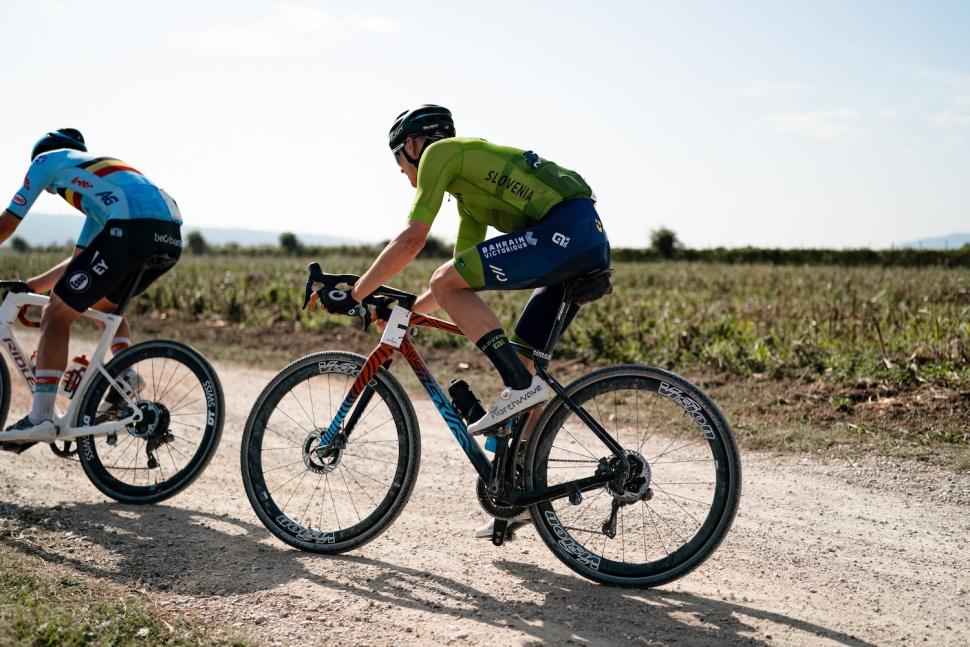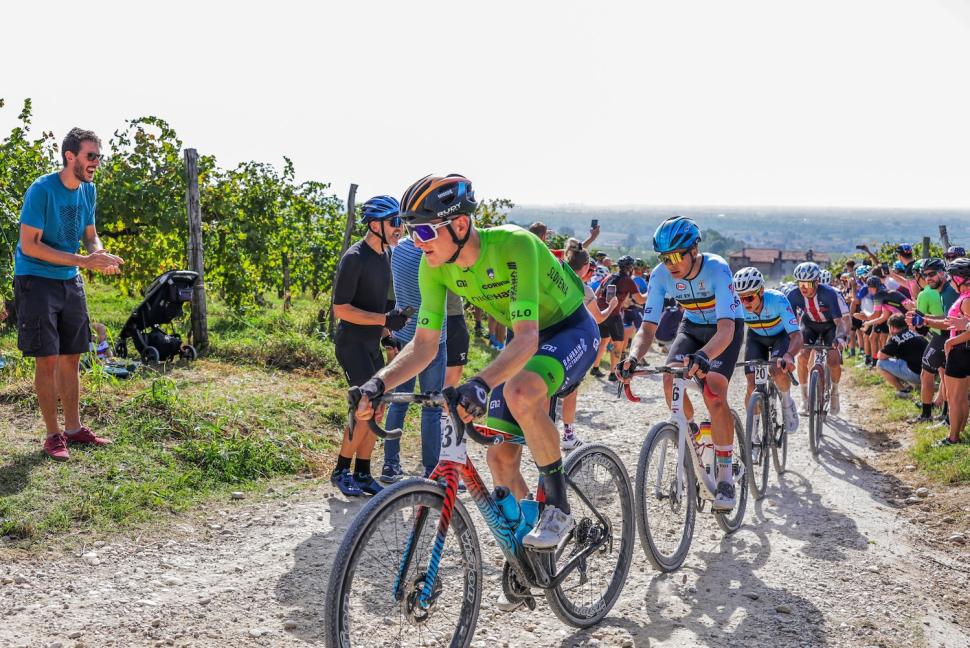- News
- Reviews
- Bikes
- Components
- Bar tape & grips
- Bottom brackets
- Brake & gear cables
- Brake & STI levers
- Brake pads & spares
- Brakes
- Cassettes & freewheels
- Chains
- Chainsets & chainrings
- Derailleurs - front
- Derailleurs - rear
- Forks
- Gear levers & shifters
- Groupsets
- Handlebars & extensions
- Headsets
- Hubs
- Inner tubes
- Pedals
- Quick releases & skewers
- Saddles
- Seatposts
- Stems
- Wheels
- Tyres
- Tubeless valves
- Accessories
- Accessories - misc
- Computer mounts
- Bags
- Bar ends
- Bike bags & cases
- Bottle cages
- Bottles
- Cameras
- Car racks
- Child seats
- Computers
- Glasses
- GPS units
- Helmets
- Lights - front
- Lights - rear
- Lights - sets
- Locks
- Mirrors
- Mudguards
- Racks
- Pumps & CO2 inflators
- Puncture kits
- Reflectives
- Smart watches
- Stands and racks
- Trailers
- Clothing
- Health, fitness and nutrition
- Tools and workshop
- Miscellaneous
- Buyers Guides
- Features
- Forum
- Recommends
- Podcast
TECH NEWS
 2023 UCI Gravel World Championships Matej Mohoric Picture by Thomas Maheux-SWpix.com © SWpix.com (t-a Photography Hub Ltd) - 1.jpeg
2023 UCI Gravel World Championships Matej Mohoric Picture by Thomas Maheux-SWpix.com © SWpix.com (t-a Photography Hub Ltd) - 1.jpegUnreleased Merida Silex raced to victory at Gravel World Champs by Matej Mohoric
Slovenia’s Matej Mohoric (Team Bahrain Victorious) won the UCI Gravel World Championships at the weekend on a yet-to-be-released new version of Merida’s Silex. Let’s take a look at the bike…
Mohoric has some huge wins to his name, including stages of all three Grand Tours and the Milan-San Remo title in 2022, but his win at the UCI Gravel World Championships was a surprise to most.
Pic: Alex Whitehead-SWpix.com © SWpix.com (t-a Photography Hub Ltd)
Last year’s inaugural UCI Gravel World Champs drew criticism from many quarters for not being very, you know, gravelly. Well, that’s a bit of an exaggeration but there were a helluva lot of aero road bikes being raced at very high speeds. Let’s just say that it wasn’t the most technical race ever.
> UCI Gravel World Championships 2023 - how the race was won
This time, the 169km (105 miles) course in Northeastern Italy’s Veneto region featured 1,890m (6,200ft) of climbing and various road surfaces, including cobbles. Mohoric tackled it on a new version of Merida’s Silex rather than the Scultura Endurance GR gravel race bike that was released back in June (click here for details on the race rather than the bike).
At the time of the Scultura Endurance GR’s launch, Merida said, “With the growing scene of fast-paced, one-day gravel races developing all over the world, it was time to add this new and exciting variation to the Merida line-up.”
> Merida introduces speed-focused Scultura Endurance GR gravel bike
Pic: Thomas Maheux-SWpix.com © SWpix.com (t-a Photography Hub Ltd)
You might have expected Mohoric to rock up on one at the Gravel World Champs but for the fact that the Scultura Endurance GR will take tyres only up to 35mm, hence his use of the Silex. Merida has confirmed that this new bike will be released on 19th October 2023… but that’s all it has said. What can we glean before the official launch?
Mohoric’s Merida Silex looks to be a broadly similar shape to the existing model in that it’s long and low-slung with a steeply sloping top tube, although that head tube does look short, giving a big old saddle-to-handlebar drop. Loads of racers go for a frame size that most of us would regard as too small simply to get to a short head tube and an aggressive ride position but we wouldn’t be surprised if Merida has been tinkering with the geometry here.
The head tube is a whole lot more round and curvy than the previous design too. It was all angles before.
Pic: Thomas Maheux-SWpix.com © SWpix.com (t-a Photography Hub Ltd)
The fork legs don’t taper to the same extent as they did, and they now come with three threaded bosses for accessories on each side rather than the previous two for those who like to head off on adventure. Merida has added bosses on top of the top tube as well. Not surprisingly, Mohoric didn’t use any of these although he did have a pack for essentials attached to his saddle rails.
Rather than an external seat clamp, Merida uses an internal wedge-type system. Previously, the carbon Silex had an unusual design where you tightened the bolt from the side of the bike, but it looks like the bolt is now recessed into the top tube. The shaping around the junction between the top tube, seat tube and seatstays has been altered accordingly.
Pic: Thomas Maheux-SWpix.com © SWpix.com (t-a Photography Hub Ltd)
Staying at the back of the bike, the chainstays are dropped on both sides, which is something we see on many gravel bikes. You can start having issues with crank clearance when you use a wider tyre; so lots of brands drop the chainstays – at least the driveside chainstay – to increase the space between the chainring and the tyre.
Nipping back up front, the existing Merida Silex has brake hoses and cables (where used) that enter the frame either at the top of the down tube or near the fork crown. Look at Mohoric’s bike, though, and you’ll see that the brake hoses are plumbed internally, seemingly using FSA’s ACR (Aero Cable Routing) system.
There would be no gear cables to see anyway because Mohoric uses a Shimano Dura-Ace Di2 setup, the shifters communicating wirelessly with the rest of the system. He rode with a compact chainset (50/34-tooth chainrings) and an 11-34-tooth cassette. That’s not a normal gravel combo, it’s what you’ll see specced on many road bikes for everyday use, although anyone racing on asphalt would typically have larger chainrings.
Pic: Simon Wilkinson-SWpix.com
Mohoric was using wheels from Vision. They look like Metron 45 SL Discs and they’re fitted with Continental Terra Speed tyres in a 40mm width, set-up tubeless.
As mentioned, Merida promises the unveiling of the new Silex on 19th October.
Mat has been in cycling media since 1996, on titles including BikeRadar, Total Bike, Total Mountain Bike, What Mountain Bike and Mountain Biking UK, and he has been editor of 220 Triathlon and Cycling Plus. Mat has been road.cc technical editor for over a decade, testing bikes, fettling the latest kit, and trying out the most up-to-the-minute clothing. He has won his category in Ironman UK 70.3 and finished on the podium in both marathons he has run. Mat is a Cambridge graduate who did a post-grad in magazine journalism, and he is a winner of the Cycling Media Award for Specialist Online Writer. Now over 50, he's riding road and gravel bikes most days for fun and fitness rather than training for competitions.
Latest Comments
- polainm 28 min 3 sec ago
1kg bike lock used as a weapon - major news story. ...
- polainm 33 min 7 sec ago
I believe it's an urban fact that there are zero cycle infrastructure experts employed in the UK.
- polainm 1 hour 3 min ago
100% this. Policing mentality is formed by social 'norms', and the cyclist witchhunting across social media is the UK norm. Close passing a person...
- whosatthewheel 1 hour 40 min ago
Exactly. We live in a jungle where the stronger always wins.
- David9694 2 hours 28 min ago
That's a clear 2 points awarded there, but I guess as there's now a 25% tariff you'll only get 1.5
- mark1a 2 hours 39 min ago
Fawkes Cycles is only local if you live near Oldham. That's nearly 300 miles away from me. Also, any retailer that doesn't participate in an...
- David9694 2 hours 41 min ago
Openreach under fire over delays to Amesbury cabinet repairs...
- Destroyer666 10 hours 39 min ago
Anodizing the aluminium is also for corrosion resistance and therefore enhances the longevity of the rims while this is not really a case for...
- bobbinogs 11 hours 53 min ago
Wheelsmith has always been very good for me. Malcolm was always very opinionated so I got bored with him telling me I should be riding tubeless,...
- Terry Hutt 12 hours 12 min ago
I assume you can carry an e-bike battery on the tube if you leave the bike at home. ...





Add new comment
3 comments
Would have been nice to be able to have watched the men's or women's races...
No dropper seatpost? If using one helped him descend the Poggio, you'd think it'd help on the descents of a gravel course.
No point, the descents were too tame